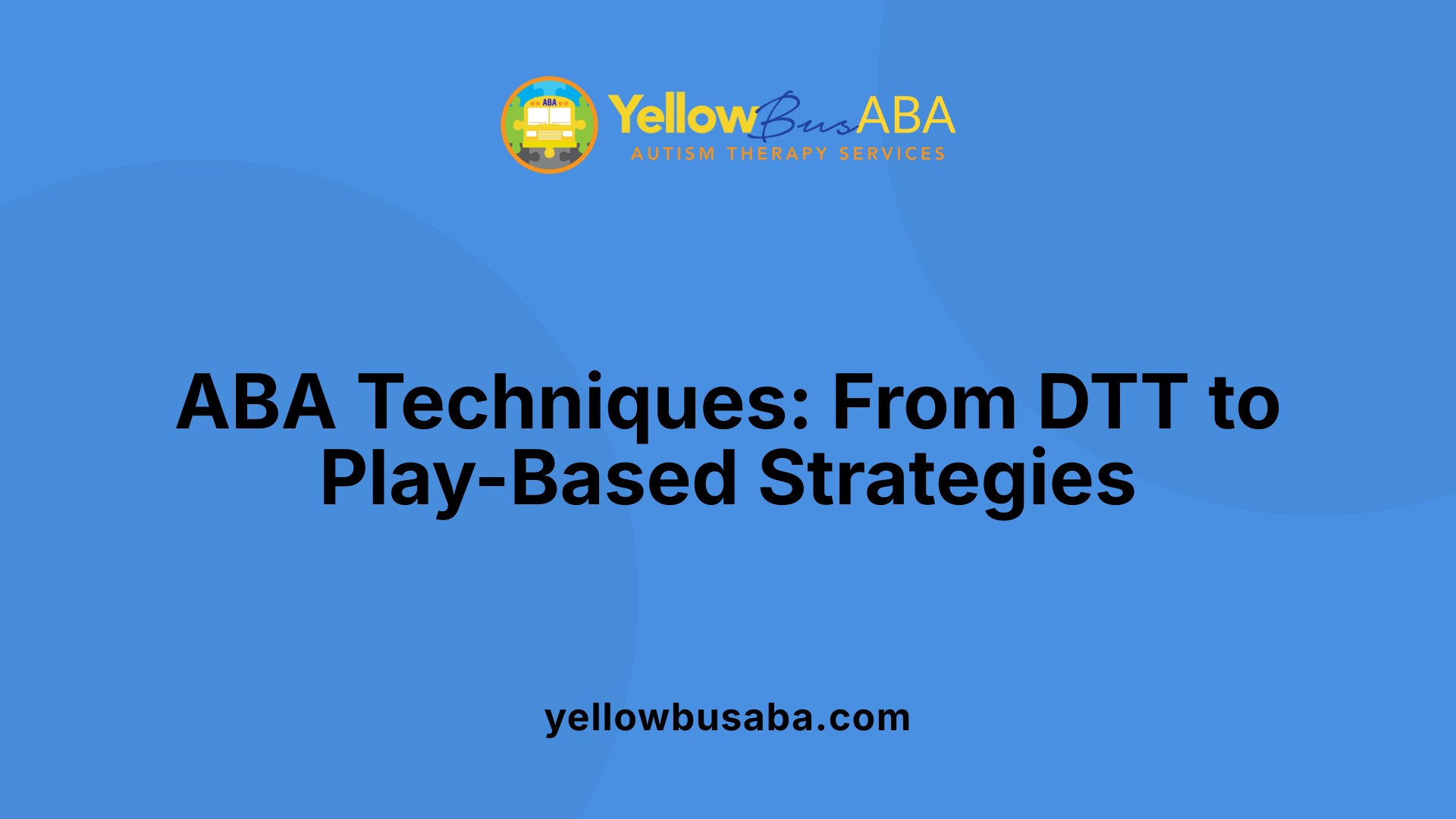Therapy Insights From Experienced Behavior Analysts
November 17, 2025
Exploring Modern Practices and Perspectives in ABA Therapy

Understanding ABA Therapy Through Expert Perspectives
Applied Behavior Analysis (ABA) therapy has become a cornerstone intervention for individuals with autism spectrum disorder (ASD). This article gathers insights from experienced behavior analysts, exploring the critical principles, practical applications, and evolving perspectives that shape ABA therapy today. From foundational scientific methods to individualized care approaches, we delve into how ABA supports skill development and behavioral improvements while addressing ongoing debates surrounding its implementation.
What is Applied Behavior Analysis (ABA) Therapy and Its Role in Autism Intervention?

Definition and Purpose of ABA Therapy
Applied Behavior Analysis (ABA) is a scientific and evidence-based therapy designed to understand and guide human behavior. In autism intervention, ABA helps individuals develop essential skills and reduce harmful or problematic behaviors by using behavioral principles such as positive reinforcement. It targets meaningful daily skills including communication, socialization, and self-care.
Scientific Basis and Evidence Supporting ABA
ABA is firmly grounded in scientific research and has been recognized by authoritative bodies like the American Psychological Association as an effective intervention for Autism Spectrum Disorder (ASD). Techniques used in ABA, such as the Antecedent-Behavior-Consequence (ABC) model and reinforcement strategies, are supported by extensive data collection and analysis.
How ABA Supports Skill Development in Autism
The therapy promotes skill acquisition by breaking behaviors into teachable components and reinforcing desired behaviors. It systematically increases positive behaviors and helps in areas such as language development, social interaction, and cognitive skills. ABA also aims to reduce behaviors that may impede learning or social participation.
Role of Reinforcement and Behavioral Principles
ABA primarily employs positive reinforcement to encourage helpful behaviors. Practitioners identify the reasons behind behaviors—like seeking attention or sensory stimulation—and modify the environment accordingly to support better outcomes. Techniques include prompting, fading, modeling, and extinction.
Individualization of ABA Programs
ABA interventions are highly personalized. Each program is based on comprehensive assessments by qualified professionals, including Board Certified Behavior Analysts (BCBAs). Treatments align with the child's strengths, interests, and specific needs, emphasizing autonomy and joy while avoiding aversive methods.
Importance of Early Intervention
Early application of ABA, especially before the age of four, is crucial. Early intervention maximizes skill-building opportunities, particularly in developing verbal and social abilities, increasing the likelihood of long-term success.
Respect for Neurodiversity within ABA
Modern ABA respects the neurodiversity of individuals, focusing on enhancing independence and participation without aiming to change a child's inherent neurological identity. The approach supports natural behaviors while promoting skills that improve quality of life.
Addressing Criticisms
While some critics point out concerns about repetition and conformity to neurotypical norms, contemporary ABA advocates emphasize individualized plans and positive strategies over punishment-based methods, ensuring emotional well-being and personal growth.
Core Principles Underpinning Behavioral Analysis in Autism Therapy

What are the core principles behind behavioral analysis used in autism therapy?
Applied Behavior Analysis (ABA) therapy is grounded in several foundational principles that guide its approach to behavior change. Central among these are reinforcement and extinction. Reinforcement involves strengthening positive behaviors by rewarding them, encouraging the child to repeat helpful actions. Extinction, conversely, focuses on reducing unwanted behaviors by withdrawing the reinforcement that maintains them.
How does the ABC model help in understanding behavior?
The Antecedent-Behavior-Consequence (ABC) model is a critical tool used in ABA. It breaks down behavior into three parts: what happens right before the behavior (Antecedent), the behavior itself, and what follows it (Consequence). This model helps therapists pinpoint triggers and outcomes of behaviors, offering a clear framework for designing interventions.
What is the role of functional behavior assessments in ABA?
Functional Behavior Assessments (FBAs) are systematic evaluations to identify why a specific behavior occurs—whether it's to gain attention, escape a demand, access tangible items, or seek sensory stimulation. Understanding the function behind a behavior informs more precise and effective treatment plans tailored to individual needs.
How does ABA promote skill building and generalization?
ABA emphasizes teaching socially significant skills through positive reinforcement. Techniques are designed not only to develop new behaviors but also to ensure these skills generalize across different environments, situations, and people. This promotes greater independence and participation in daily life.
What scientific methods support behavior change in ABA?
ABA therapy relies on data-driven approaches, including systematic data collection and analysis. This ensures ongoing monitoring and adjustment of interventions based on empirical evidence. Board Certified Behavior Analysts oversee these processes to maintain safety, effectiveness, and individualization of therapy.
| Principle | Description | Role in ABA Therapy |
|---|---|---|
| Reinforcement | Strengthening behaviors by rewarding positive actions | Encourages repetition of helpful behaviors |
| Extinction | Reducing behaviors by withholding reinforcement | Discourages problematic behaviors |
| ABC Model | Analyzing Antecedent, Behavior, Consequence | Identifies triggers and outcomes to design interventions |
| Functional Behavior Assessment | Systematic evaluation of behavior purpose | Guides individualized and targeted intervention plans |
| Skill Building & Generalization | Teaching new skills and applying them across environments | Promotes independence and sustained behavior change |
| Scientific Method | Data collection and evidence-based adjustment of therapy | Ensures effective, personalized, and ethical treatment |
Techniques and Therapeutic Approaches Utilized by ABA Practitioners

Positive Reinforcement and Shaping
ABA therapy heavily relies on positive reinforcement, rewarding desired behaviors to encourage their repetition. Shaping is used to gradually guide a child toward a target behavior by reinforcing successive approximations, ensuring progress in small, achievable steps.
Discrete Trial Training (DTT)
DTT is one of the structured techniques originally used in ABA. It breaks down skills into clear, concise trials with specific instructions and immediate reinforcement. While early forms involved some aversive methods, modern DTT emphasizes positive strategies and is often delivered in a play-based setting.
Natural Environment Training (NET)
NET focuses on teaching skills in everyday, natural settings rather than formal sessions. This technique utilizes the child's interests and play to promote learning, making the therapy feel more enjoyable and relevant to daily life.
Picture Exchange Communication System (PECS)
PECS is a communication tool where children use pictures to express needs and thoughts. It is especially helpful for children at risk of not developing verbal skills, enabling better communication and reducing frustration.
Prompting and Fading
ABA practitioners use prompts such as verbal cues or physical guidance to help elicit correct responses. Gradually, these prompts are faded out to encourage independent skill use.
Behavior Chains and Contracts
Behavior chains break down complex tasks into smaller linked steps that a child learns in sequence. Behavior contracts may involve agreed-upon contingencies to motivate and clarify expectations.
Modeling, Redirection, and Script Fading
Modeling involves demonstrating desired behaviors for imitation. Redirection guides children away from undesired actions. Script fading helps children transition from repetitive or scripted language toward more functional communication.
These diverse ABA techniques form a comprehensive, adaptable framework that practitioners tailor to each child's unique strengths and needs, focusing on promoting positive behaviors, enhancing communication, and fostering autonomy.
Role and Training of ABA Therapy Providers

Who typically provides ABA therapy for autism?
ABA therapy for autism is delivered by specialized professionals trained in behavior analysis. The primary providers include Board Certified Behavior Analysts (BCBAs), who are responsible for designing and overseeing individualized treatment programs tailored to each child’s needs.
Roles of BCBAs, BCaBAs, and technicians
BCBAs create comprehensive behavior intervention plans and supervise therapy sessions. Board Certified Assistant Behavior Analysts (BCaBAs) assist BCBAs and may provide therapy under their supervision. Registered Behavior Technicians (RBTs) or behavior therapists implement these plans through hands-on sessions, employing ABA techniques like positive reinforcement and modeling.
Certification and formal training requirements
Professionals must complete rigorous formal training, including graduate-level coursework. Certification involves passing exams such as the BCBA exam, which validates expertise in ABA principles and practice.
Graduate programs and Board Certification
Graduate programs, like those offered by UMass Global, provide certificates and master's degrees focused on ABA. These programs prepare candidates for certification and a career in behavior analysis.
Importance of supervision and competency assessments
Technicians and therapists work under BCBA supervision, ensuring treatment fidelity. Ongoing competency assessments guarantee high standards of practice and effective intervention delivery.
Family collaboration and caregiver training
Successful ABA therapy involves training families to reinforce skills at home, promoting generalization and lasting progress. Collaborating with caregivers is a vital component of treatment plans to support the child’s independence and functioning across environments.
The Assessment and Individualization Process in ABA Therapy

Initial Behavioral Assessment and Functional Behavior Analysis
ABA therapy begins with a thorough behavioral assessment and functional behavior analysis. This helps identify the specific behaviors, their triggers, and functions such as escape, attention-seeking, or sensory stimulation. Understanding why a behavior occurs lays the foundation for creating an effective intervention.
Goal Setting Tailored to Individual Needs
Based on the assessment data, personalized goals are established. These goals focus on increasing positive behaviors, teaching daily communication and social skills, and reducing harmful behaviors, all tailored to the child’s unique needs and developmental level.
Data-Driven Development of Treatment Plans
Treatment plans in ABA are developed using systematic data collection to guide decisions. Practitioners use principles like positive reinforcement and shaping, designing programs that are evidence-based and scientifically grounded.
Ongoing Monitoring and Adjustments
ABA therapy involves continuous monitoring of progress. Data is regularly reviewed by Board Certified Behavior Analysts (BCBAs) to adjust interventions accordingly, ensuring the child’s evolving needs are addressed in real time.
Importance of Incorporating Strengths and Interests
Modern ABA emphasizes building on a child’s strengths and interests to promote joy and autonomy. This approach makes learning engaging and supports natural learning opportunities.
Integration of Naturalistic and Play-Based Methods
Current ABA programs often integrate play-based and naturalistic approaches rather than relying solely on structured techniques. This helps create a supportive environment that fosters independence and participation without the use of aversive methods.
Measuring Effectiveness: Tracking Progress in ABA Therapy
How is the effectiveness of ABA therapy for autism typically measured?
ABA therapy's effectiveness hinges on systematic data collection and behavioral tracking. Practitioners start by setting measurable goals and objectives tailored to the individual child's needs. These goals often focus on communication, social skills, daily living skills, and reducing problem behaviors.
To monitor progress, ABA therapists use various methods, including recording the frequency, duration, or intensity of specific target behaviors. Tools such as the Antecedent-Behavior-Consequence (ABC) model help identify why behaviors occur and inform intervention strategies.
Visual data representation is crucial; charts and graphs allow both therapists and families to clearly see changes over time. Progress is regularly analyzed to adjust treatment plans, ensuring interventions remain effective and focused on the child's strengths and interests.
Evaluating improvements covers multiple domains:
- Communication: Increased verbal skills, use of alternative communication methods
- Social interaction: Enhanced engagement and positive social behaviors
- Behavioral regulation: Decreases in harmful or disruptive behaviors
Experimental designs, such as reversal or alternating treatments, are sometimes employed to confirm that observed improvements are directly due to ABA interventions. This scientific approach ensures that changes are meaningful and attributable to therapy efforts.
Through careful measurement and ongoing assessment, ABA therapy provides evidence-based benefits that support the child's development and independence.
Modern ABA: Positive, Naturalistic, and Play-Based Practices
Transition from Aversive Methods to Reinforcement
Modern Applied Behavior Analysis (ABA) has significantly evolved from its earlier forms, such as Discrete Trial Training (DTT), which sometimes utilized punishment techniques. Today, ABA focuses on positive reinforcement strategies that encourage desired behaviors rather than relying on aversive methods like electric shocks. This shift ensures interventions are more humane and supportive.
Incorporation of Child’s Interests and Strengths
Contemporary ABA programs emphasize tailoring interventions to an individual child’s interests and strengths. This personalized approach helps increase engagement and motivation, supporting skill development in a joyful and empowering way.
Use of Natural Environment Training (NET)
Natural Environment Training (NET) is a cornerstone of modern ABA, integrating learning opportunities into everyday play and routines. By teaching skills in natural contexts, children can better generalize behaviors beyond artificial clinical settings, fostering practical and functional outcomes.
Focus on Joy, Autonomy, and Empowerment
Current ABA practices prioritize the child’s happiness and autonomy. Therapists aim to empower children by promoting independence and offering choices in therapy activities, ensuring interventions support emotional well-being alongside skill acquisition.
Emphasis on Reducing Intensity and Repetition
Unlike traditional models that might demand extensive hours weekly, modern ABA tends to use more moderate session lengths, often around 10-20 hours per week. This reduction lessens fatigue and boredom, while incorporating varied, play-based activities to sustain interest.
Promoting Generalization Beyond Clinical Settings
Effective modern ABA programs actively involve families and natural settings to encourage the transfer of learned skills across environments. This generalization is crucial for meaningful, real-world improvements in communication, socialization, and daily living skills.
Addressing Criticisms and Ethical Considerations in ABA
Historical context of aversive practices and their rejection
Early forms of ABA, such as Discrete Trial Training, sometimes included aversive methods like punishment and electric shocks to reduce unwanted behaviors. These practices have since been widely rejected. Modern ABA emphasizes positive reinforcement and avoids harmful techniques, focusing instead on supportive, respectful interventions.
Concerns about emotional distress and intensity
Critics often highlight that ABA's repetitive and intensive nature can be demanding and emotionally challenging for some children. Programs are sometimes perceived as coercive if not carefully tailored, potentially causing distress rather than support.
Debate on conformity versus neurodiversity acceptance
There is an ongoing debate regarding ABA's focus on modifying behaviors to fit neurotypical standards. Some argue this emphasis may suppress natural autistic behaviors, leading to concerns about undermining the acceptance of neurodiversity.
Potential for masking and emotional harm
One critical concern is that intensive ABA may encourage masking — where autistic individuals hide their authentic behaviors to conform — which can result in emotional harm and reduced well-being if their emotional needs are not properly addressed.
Current emphasis on respectful, individualized approaches
Contemporary ABA programs increasingly prioritize individualized interventions that build on a child's strengths and interests. Therapists focus on promoting joy, autonomy, and independence, steering clear of the old punitive strategies.
Advocacy for balancing skill-building with identity respect
Supporters of modern ABA advocate for a balanced approach that fosters skill acquisition and independence while respecting the child's identity and neurodiversity. Family involvement and individualized goal setting ensure therapies meet emotional and developmental needs.
| Criticism or Concern | Description | Modern ABA Response |
|---|---|---|
| Use of Aversive Methods | Early use of punishment and shocks | Rejected; emphasis on positive reinforcement |
| Emotional Distress | Repetitive and demanding interventions may cause stress | Protocols tailored individually to reduce distress |
| Focus on Conformity | Risk of suppressing natural autistic behaviors | Emphasis on promoting independence and participation |
| Masking and Emotional Harm | Suppressing true behavior can harm emotional well-being | Encourage autonomy and emotional support |
| Ethical Considerations | Importance of respecting the child's neurodiversity and dignity | Personalized programs aligned with family and child needs |
ABA Therapy in Diverse Settings and Populations
Clinical Applications for Children and Young Adults
ABA therapy is most commonly applied in clinical settings targeting children and young adults, particularly those with autism spectrum disorder (ASD). Programs often focus on preschool and elementary-aged children, aiming to improve learning, social communication, self-help skills, and behavior management. These clinical interventions are carefully individualized and closely monitored by Board-Certified Behavior Analysts (BCBAs).
Educational Settings and Private Practice
ABA also plays a vital role in educational environments where therapists collaborate with teachers to facilitate learning adaptations and social skills development. Private practices provide flexible, tailored ABA services to meet diverse client needs, often emphasizing naturalistic and play-based methods that foster autonomy and enjoyment.
Use in Senior Care and Mental Health Contexts
Beyond childhood autism interventions, ABA methods support seniors facing health and mental challenges. ABA principles help improve cognitive functioning, reduce problematic behaviors, and enhance emotional regulation among elderly populations, adapting strategies to suit age-related changes.
Supporting Individuals Beyond Autism, Including Developmental Disorders
ABA’s scope extends to individuals with other developmental disorders and behavioral health issues. Its systematic, data-driven approach identifies behavioral functions and applies positive reinforcement to promote desirable behaviors while reducing harmful ones.
Customizing Interventions by Age and Developmental Level
Programs are tailored to each individual's age, developmental stage, and specific needs. Early interventions typically emphasize speech and communication development, while programs for older clients focus more on independence and daily living skills. This customization ensures interventions are relevant and effective across a broad spectrum of abilities.
Multidisciplinary Collaboration
Successful ABA therapy often involves close collaboration among BCBAs, therapists, educators, medical professionals, and families. This multidisciplinary approach ensures comprehensive understanding and reinforcement of skills across different environments, promoting generalized and sustainable progress.
Cost, Insurance, and Accessibility of ABA Therapy
What are the typical costs of ABA therapy sessions?
ABA therapy costs around $120 per hour when provided by a board-certified ABA therapist. This rate reflects the specialized training and expertise required to deliver effective interventions.
What factors influence the variability in ABA therapy costs?
Several factors affect the cost of ABA therapy, including:
- Severity of the condition: More intensive needs may require longer sessions.
- Program intensity: Higher weekly hours increase total expenses.
- Provider qualifications: BCBA-led programs usually cost more than those led by technicians.
- Geographical location: Costs vary depending on local demand and availability.
- Treatment setting: Clinic-based versus home-based sessions can differ in price.
How is insurance coverage handled for ABA therapy?
Insurance coverage for ABA therapy varies widely by region. Some states such as California, Massachusetts, and Indiana have mandates requiring insurers to cover ABA therapy for autism spectrum disorder. Other regions may lack comprehensive mandates, leading to gaps in accessibility.
What resources are available to help families navigate insurance coverage?
Families often face challenges understanding and accessing available insurance benefits. Specialized advocates and nonprofit organizations provide guidance and support to help families secure coverage and financial assistance.
How do financial barriers impact access to ABA therapy?
High costs and inconsistent insurance coverage can limit therapy access for many families, potentially delaying early intervention and affecting long-term outcomes for children with autism.
Are there model programs or policy trends improving availability?
Recent policy trends focus on expanding insurance mandates and increasing public funding for ABA. Institutions and advocacy groups are working to develop affordable and scalable programs that reduce financial obstacles while maintaining quality care.
Importance of Family and Caregiver Involvement in ABA
Collaborative role of families in treatment
Families and caregivers play an essential part in the success of ABA therapy. Their involvement helps ensure the strategies used by therapists are reinforced consistently outside clinical sessions, fostering skill development in everyday settings.
Skill generalization at home and community
ABA therapy aims not only to teach new skills but to help children apply them across various environments. Families support this by encouraging practice of learned behaviors at home and in social situations, promoting independence and participation.
Training families to implement strategies
ABA practitioners often train family members to use specific techniques such as positive reinforcement and prompting. This training empowers caregivers to carry out interventions effectively, ensuring continuity and maximizing therapeutic benefits.
Communication between therapists and caregivers
Open and ongoing communication between therapists and families is critical. Sharing progress updates, discussing challenges, and adjusting goals collaboratively aid in tailoring treatment plans to the child’s evolving needs.
Building supportive environments
Caregivers help create environments that encourage positive behaviors and reduce triggers for challenging behaviors. This supportive setting is vital for sustaining progress and enhancing the child's comfort and engagement.
Sustaining gains through consistent reinforcement
Consistent reinforcement of targeted behaviors by families across different contexts helps solidify gains made during therapy. This continuity is pivotal for the long-term success and autonomy of the child.
Future Directions and Research Insights in ABA Therapy
Ongoing Improvements in Individualized Programming
Modern ABA therapy is increasingly personalized, focusing on building upon the child's strengths and interests to promote joy and autonomy. Rather than using rigid, repetitive approaches, programs now adapt to the unique needs of each child, ensuring interventions are meaningful and engaging.
Innovations in Naturalistic and Strength-Based Methods
There is a clear shift toward play-based and naturalistic ABA strategies that avoid aversive techniques. Strength-based approaches emphasize positive reinforcement within natural environments, aiming to increase independence and social participation without suppressing natural behaviors.
Research Supporting Evidence-Based Practices
Research continues to validate ABA as an evidence-based intervention, with organizations like the American Psychological Association endorsing its efficacy. Studies increasingly highlight the benefits of early intervention, especially for developing verbal skills and reducing harmful behaviors, reinforcing the science behind ABA’s core principles.
Technological Advancements Aiding Assessment and Delivery
Emerging technologies are enhancing ABA therapy through precise data collection and real-time analysis, enabling practitioners to adjust treatment plans dynamically. Digital platforms also support remote monitoring and family collaboration, expanding access and consistency in care.
Growing Emphasis on Emotional Well-Being and Autonomy
Modern ABA practices increasingly recognize the importance of emotional needs and aim to promote autonomy rather than merely suppress behaviors. This compassionate focus helps ensure therapy respects neurodiversity and supports emotional regulation alongside skill development.
Balancing Scientific Rigor with Compassionate Care
Future ABA evolutions strive to balance rigorous scientific methods with empathetic, individualized care. Practitioners are trained to implement data-driven interventions while fostering positive experiences that honor each child's unique identity and consent.
| Innovation Area | Description | Impact on ABA Practice |
|---|---|---|
| Individualized Programming | Tailoring interventions based on child's strengths and interests | Increased engagement, autonomy, and meaningful outcomes |
| Naturalistic Methods | Using play-based, less aversive approaches | Improved child comfort and natural skill generalization |
| Evidence-Based Research | Ongoing validation through studies and endorsements | Reinforced credibility and optimized early interventions |
| Technology Integration | Data-driven tools, remote monitoring, digital platforms | Enhanced precision, access, and family involvement |
| Emotional Well-Being Focus | Addressing emotional needs and promoting neurodiversity | Holistic care supporting mental health and self-regulation |
| Compassionate Scientific Balance | Combining data with empathy and respect for individuality | Ethical practice fostering trust and sustained participation |
Concluding Perspectives from Behavior Analysts
Experienced behavior analysts emphasize ABA therapy's evolving nature as both a science and an art, grounded in rigorous evidence and personalized care. Modern ABA prioritizes positive reinforcement, respect for neurodiversity, and meaningful collaboration with families. Despite valid criticisms, contemporary practices aim to promote autonomy, joy, and lasting skill development for individuals with autism and beyond. As research advances and ethical considerations deepen, ABA continues to refine its approaches, ensuring that therapy remains effective, humane, and empowering, offering valuable insights for practitioners and families alike.
References
- The Controversy Around ABA
- What Is Applied Behavior Analysis - Exploring ABA ...
- What is an ABA therapist? Insights for Families New to ABA
- Exploring Applied Behavioral Analysis (ABA) Therapy
- Applied Behavioral Analysis: Overview, Techniques & Cost
- The Controversy Around ABA
- Is ABA therapy harmful? The controversy explained






